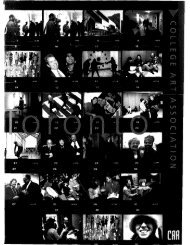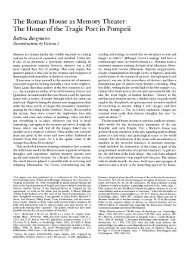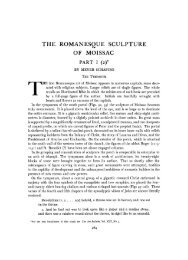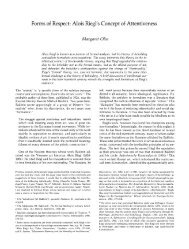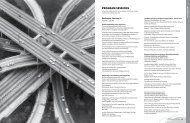THE HUMANISTIC THEORY OF PAINTING - College Art Association
THE HUMANISTIC THEORY OF PAINTING - College Art Association
THE HUMANISTIC THEORY OF PAINTING - College Art Association
Create successful ePaper yourself
Turn your PDF publications into a flip-book with our unique Google optimized e-Paper software.
UT PICTURA POESIS: <strong>HUMANISTIC</strong> <strong>THE</strong>ORY <strong>OF</strong> <strong>PAINTING</strong> 241<br />
other Egyptian local color, he had availed himself of the natural and moral history of the<br />
Egyptians displayed in the mosaic pavement of the Temple of Fortune in Palestrina.212<br />
And we have already seen that he could take an imputation of factual inaccuracy in his<br />
painting seriously enough to argue the point in an effort to prove himself a good historian.<br />
Yet for all his Roman learning and his conscientiousness he was far from being elaborately<br />
learned in what was called the science of costume213-that exact knowledge of the habits,<br />
customs, and local color of various peoples and countries, that the critics in the name of<br />
decorum or verisimilitude insisted upon as necessary to the painter of history. To be so<br />
he would have had to travel to other lands than Italy, as Delacroix and Decamps were to<br />
do in the nineteenth century, when curiously enough the Romantic Movement encouraged<br />
exact reproduction of the scene and dress of foreign lands that were far closer to what the<br />
academic critics of the sixteenth and seventeenth centuries demanded than anything pro-<br />
duced in their own time. But always in his great histories, and even in those cases in which,<br />
as we have just seen, he attempted to locate his scene geographically, Poussin's landscape,<br />
architecture, and dress are generalizations based on Italian or on classical forms with which<br />
the exact science of costume has little to do, and in which even his Roman learning is entirely<br />
subsumed. And this subordination of learning to artistic creation was as inevitable in<br />
Poussin as it must be in any great and learned painter who sees the forms of nature or the<br />
actions of men under the aspect of eternity. A less profound spirit like Le Brun who held<br />
by the rules and sponsored an academic program might, as Du Bos tells us, have someone<br />
draw Persian horses for him at Aleppo in order that he might observe costume in his his-<br />
tories of Alexander.214 But if one turns to the great painters of the Renaissance who flour-<br />
ished before the doctrine of the learned painter developed, certainly it is true that when they<br />
illustrated the fables of the poets or subjects from history or scripture they were never,<br />
for all their association with humanists, primarily scholars themselves, nor concerned<br />
primarily with the scrupulous following of texts; but treated their literary material freely<br />
and imaginatively, adapting it to the possibilities of their own medium of expression and<br />
to the traditional language of their own art. Thus, one may repeat, the learned, nay<br />
pedantic painter, was never so much an actuality as he was an idea whom the sixteenth-<br />
century critics created far more in their own image than on the basis of knowledge actually<br />
revealed by the great painters in their art-some of whom, as we have seen, they occa-<br />
sionally took to task for what one might call their misquotation of poetic or historical<br />
texts. It is not surprising that this theory should first evolve in a century that saw a<br />
decline in the creative energy both of art and scholarship; and like much of the Mannerist<br />
art of the period it is a distortion of objective truth. What several critics required of the<br />
sixteenth-century painter in the way of erudition we have already seen. And from 1550<br />
to 1750 a host of passages might be quoted in which the mantle of poet, historian, or sage,<br />
is made to descend upon the painter's innocent shoulders or in which he is enjoined to<br />
deal accurately with the printed word. Near the end of the critical tradition of the Renais-<br />
sance the eighteenth-century English painter and critic, Jonathan Richardson, who was<br />
respected in his day, after remarking on the universal language of painting (by which he<br />
212. Letter to Chantelou of November 25, 1658<br />
(Jouanny, p. 448). See Friedlaender, op. cit., p. 123 and<br />
drawing on p. 257. Rubens' antiquarian interests also led<br />
him to be conscientious in matters of historical detail, and<br />
he was praised for his historical exactitude even to the<br />
rendering of the nails in the boots of one of the chevaliers<br />
in a painting of the Constantine series. Professor A. M.<br />
Friend has called my attention to Peiresc's letter to Rubens<br />
in which this praise is recorded (see M. Rooses, L'auvre de<br />
P. P. Rubens, Antwerp, 1890o, III, 217).<br />
213. See F61ibien, Preface, p. 317, and Du Bos in<br />
Appendix 6.<br />
214. Op. cit., p. 275.



